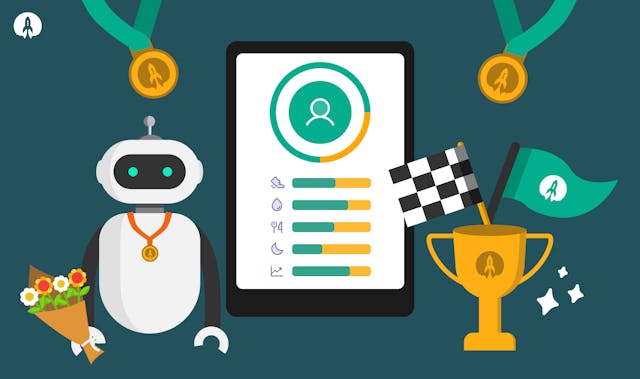14 software development trends for 2022

The pace at which innovation and technology are evolving shows no sure sign of slowing down. And with this, comes the need for high-quality software development. As we journey further into 2022, which trends are likely to feature prominently in the software development industry this year?
Here at Rocketmakers, we’ve put our heads together and come up with our predictions for what 2022 has in store for the ever-evolving world of software. After all, to stay current, you not only need to consider the present state of technology, but you must also look ahead. So, without further ado, let’s get right into it!
1 – The movement away from legacy systems continues
In 2022, we anticipate the further acceleration away from legacy systems and its security vulnerabilities and compatibility issues. Instead, businesses are rapidly evaluating and modernising their systems and tech stack in an effort to digitise and optimise their operations, increase customer expectations, and support adoption and integration with newer technology platforms.
2 – Kubernetes is king
With increased demands comes the need to deliver software faster, which has forced many companies to migrate to containers. Kubernetes is the leading platform for managing containerised applications and has enabled developers to automate the time-consuming deployment process and instead focus on things such as creating new features. With this increased efficiency and reduced software deployment lead time, it is becoming the obvious choice to automate software delivery.
3 – LCNC will continue to blossom
According to recent research from Gartner, 70 percent of new applications developed by organisations will use low-code or no-code (LCNC) technologies by 2025, up from less than 25 percent in 2020. LCNC aims to lower the barrier to developing web and mobile apps. For designers, there appears to be a growing number of use cases where LCNC can speed up the application development process. This year, we will see the use cases for LCNC continue to expand with things such as websites and landing pages, workflow management, e-commerce, AI, and more.
4 – A growing need for outsourcing
Software development outsourcing certainly proved its worth during the pandemic, demonstrating its value as an effective contributor to long-term business resilience and digital innovation at a time when it was needed most. The wins experienced by leaning on software design and development agencies during this time (cost efficiency, access to top talent, technologies, and scalable solutions, faster turnaround, lower risk, to name but a few examples) highlighted the need for smart outsourcing strategies beyond the pandemic. As such, this year we should expect more businesses to outsource software development to on-shore agencies and reap its many benefits.
5– AI and ML will continue to enhance software development
This year we should expect to witness a wave of software turning applied artificial intelligence (AI) and machine learning (ML) into a reality. These are no longer just buzzwords, but instead technology that has proven time and time again its power in changing how teams develop and deploy software by transforming productivity and processes, with much less effort. Emerging terminologies such as AIOps (artificial intelligence operations) and MLOps (machine learning operations) are here to stay and the value of automation will continue to be realised in 2022.
6 – The rise of software transparency
Consumers and clients are demanding more transparency over how software is using their data. As a result, there is a greater demand for more transparency regarding software development. Demand for answers to questions such as how tech businesses are building software, the period in which they will maintain it, and how data is collected, exchanged and stored will be likely to increase, with SaaS companies expected to communicate more openly and honestly about outages and data breaches. It’s likely that we will also see an increase in companies sharing their product roadmaps with the public, allowing clients to share direct feedback on features, having a say in shaping the products that will serve them.
7 – A pragmatic focus on coding standards
As the software developer landscape continues to grow —both in-house and agency — the need for teams to establish a list of rules and guidelines for writing quality code will become paramount. Setting out a clearly defined standard of coding will not only help the most seasoned programmer improve code quality issues, but also it will become especially valuable in the onboarding of new developers.
8 – Ethical AI will take centre stage
Artificial intelligence has been a running theme within this article of 2022 software development trends. The power of this technology and its impact on the world cannot be understated. But with this comes the need for the industry to develop a set of principles, guidelines and regulations to ensure ethical behaviours from those building such systems. More clarity and conversation around ethical AI will be expected this year.
9 – Python slithers up the popularity scale
In the last few years, there has been an incredible boom in Python uptake, leaving the language second in the popularity league table after JavaScript. Its rapid growth can largely be attributed to it being an excellent language option for building applications with AI and ML-based features — which, of course, have been really popular in recent years.
10 – Increased usage of predictive analytics
Using a combination of machine learning, data mining and statistics, predictive analytics probes historical data in order to make predictions about future outcomes (as its name suggests!) For software development specifically, it is uncovering valuable insights into product development and design. For example, it’s helping to determine which features to add to a product and also potential customers. Hence this year, we expect many more developers to use predictive analytics to drive decision making in the quest to meet their clients’ needs and win the race against competitors.
11 – The growing use of Blockchain
Unless you’ve been living under a rock, we’re willing to bet you have heard all about blockchain. From being the technology behind cryptocurrencies such as Bitcoin and Ethereum to helping people prove ownership of connected digital art and sneakers (yes, we’re talking about NFTs). The transparency that blockchain is enabling, makes it no surprise that this technology has become so popular. And with global spending on blockchain solutions predicted by IDC to reach almost $19 Billion in 2024, it’s clear to see that its demand is only going to go up from here.
12 – A rise in iOS and Android app development
In today’s digital era, it is no longer simply a luxury for a business to have an app. For some industries, it has become vital. The popularity of mobile apps in recent years has led to a rise in native mobile app development, as businesses increasingly understand that it can be a lot more rewarding in the long run.
13 – IoT continues to expand
The Internet of Things (IoT) will continue to trend in 2022. IoT devices are providing incredible benefits for both businesses and consumers. It’s streamlining various business processes across all kinds of industries and enabling organisations to create features and devices that consumers are looking for. And with sensor technology becoming more advanced and more affordable, we expect the uptake of IoT applications to rise even further.
14 – A growth of Progressive Web Applications (PWA)
While Progressive Web Apps (PWA) aren’t exactly new, the app solutions which combine the capabilities of a website with a mobile app have really started to pick up pace. As Apple’s iOS gradually allows more PWA capabilities like Android, PWA’s look set to deliver cross-platform web apps that provide a similar experience as native apps. They may be more responsive and can cost less in terms of development and maintenance, positioning themselves as an attractive choice for startups or smaller businesses that are looking to bring an app to market in 2022.
There we have it — a list of predictions for software development trends that are likely to take off (or gain faster momentum) in 2022. What trends have caught your eye? Drop us a line today for a chat!



